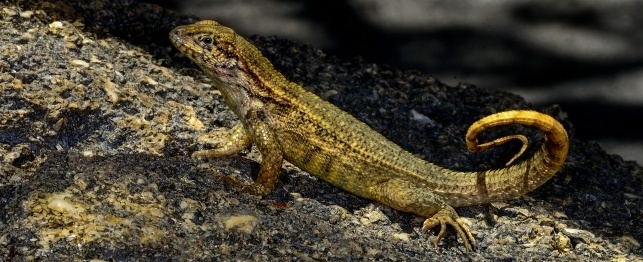

Reptiles
This reptile's common name is derived from the lizard's habit of curling the tip of its tail upwards when it comes to a stop. It is a moderately sized primarily insectivorous lizard that has no bright colors. Yet it is attractive, in its own quiet way.
The northern curly-tailed lizard, Leiocephalus carinatus armouri, measures from 8 1/2 to 10 inches in length as an adult, about half of which is tail. These lizards are the only representatives of the tropidurine lizards in the United States. They resemble the swifts, spiny lizards or fence lizards (genus Sceloporus) that can be found in one species or another throughout much of North America.
The northern curly-tailed lizard is a Bahamian native. Those available in the American pet trade are collected from the populations on Florida's southeastern coast. There are no commercial captive breeding programs. In captivity, they can live upwards of 10 years.
The northern curly-tailed lizard has a stout build with rough but not spiny scales, except the vertebral row (raised into a low crest), and is gray to brown in color. Its back is dark, its sides are somewhat lighter and its belly is almost white. Dark spots usually dot its back. Its lips are pale and there is at least an indication of a light stripe along each side of the back. The throat is light. The tail is dark banded. There are no established color variations.
This lizard is alert, and can be fast on its feet if it feels threatened. It moves in short bursts of speed, usually curling its tail upwards after each burst. With gentle, slow and persistent overtures, captives can become quite tame. Some specimens may become tame enough to allow some handling.
Although it can climb, the curly-tail is more at home on the ground. Many of these reptiles can be found near construction rubble or rocky seashores. In southeastern Florida they can be spied on seawalls, curbs or decorative piles of limestone boulders. They bask in the sunlight for long periods, moving into the shadows when approaching their optimum body temperature.
Curly-tails are small, alert, active and terrestrial lizards. One or two lizards should be given a minimum floor space of 12 by 30 inches, the space of a 20-gallon long aquarium, but larger would be better. If you have three or more lizards, you'll need a tank of 40 to 75 gallons.
The tank should have a sandy substrate and rocks that are stacked carefully so that they won't topple and trap, injure or kill your lizards. If hiding areas are not available between the rocks, provide cork bark or other commercial hides. You will also have to create a lighted basking spot, preferably on a flat rock, with a surface temperature of 98 to 110 degrees Fahrenheit. Curly-tails love to bask but they do not always ascend to the highest point, as many lizards do, to accomplish this.
Coordinate the basking time with the hours of daylight in your area – longest in mid-summer and shortest in mid-winter. Keep the remainder of the cage in the high 70s to mid 80s. Nighttime temperatures should be a little cooler and, of course, the basking light should be turned off. Winter temperatures, including that of the basking spot, can be allowed to drop a few more degrees – mid-60s F at night, low 80s F during the day and 90 F in the basking spot.
A shallow dish of fresh water should always be available.
Captive curly-tails will eat roaches, crickets, mealworms, king mealworms, silkworms and an occasional blossom. Feed them only healthy, gut-loaded insects. Curly-tails also will lap up a vitamin-fortified, honey-pureed fruit mixture. To make this, mix 1/3 water, 1/3 pureed apricot baby food, 1/3 honey. Add a little powdered calcium-D3 additive, mix well and refrigerate what is not immediately used. These lizards will drink from a dish and fresh water should always be available.
Even when restrained curly-tails may not bite, but they can. Their claws are sharp but small. In fact, the curly-tail is a pretty innocuous lizard overall.
Curly-tails are adept at avoiding capture, even in a terrarium. The best way to tame a lizard is to acclimate it to being fed by hand. Initially, feed your curly-tail a king mealworm with forceps. After it becomes used to this, let it eat from your fingertips. Do this until your lizard becomes comfortable with the procedure, and then offer it a mealworm or waxworm from the open palm of your hand. Let the lizard come to you, rather than you going to your lizard. With persistence on your part, curly-tails eventually will be eager to clamber into the palm of your hand to be fed.
However, they do not like to be grasped or otherwise restrained. The tail of this lizard will break off if it is grasped or damaged. Although the tail will regenerate, the new tail is never as neatly scaled or mobile as the original. Do not hold a lizard by its tail. And always wash your hands after handling a lizard or working in its terrarium.
Curly-tailed lizards are very hardy. If terrarium temperatures are suitably warm, they seldom develop any medical problems.
Copyright © 2005-2016 Pet Information All Rights Reserved
Contact us: www162date@outlook.com